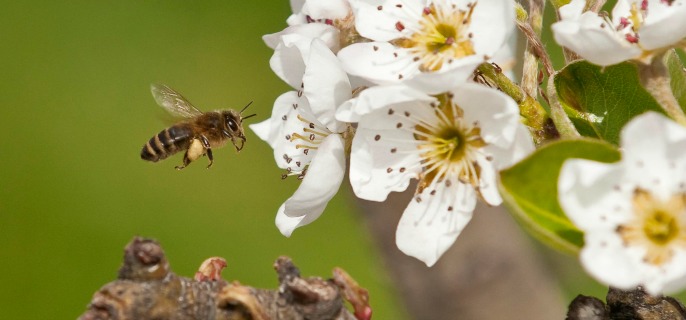
PHOTO COURTESY OF ODA
Warmer temperatures this spring are generally promoting early flowering of plants as well as moving up the timetable for pollinator activity. Now is a good time for homeowners in Oregon to take steps that will “bee friendly” to a very important ally in the insect world.
“We are starting to see a lot of bees emerging, particularly native pollinators,” says Rose Kachadoorian, an entomologist with the Oregon Department of Agriculture’s Pesticides Program. “Honeybees are showing up in the urban environment, too. It’s a perfect time for homeowners to start looking at the plants in their yard and garden to make sure they are pollinator-friendly.”
With nationwide concerns about declining bee populations, ordinary citizens can play a big role in protecting pollinators. It starts with the landscape. Since pollinators actively seek flowering plants in bloom, it’s beneficial to extend the blooming season.
“A lot of us have plants in our yard that bloom in the spring and early summer, but towards the end of summer, there isn’t a lot of blooming going on,” says Kachadoorian. “Now is a great opportunity to purchase some plants that will bloom later on in the year. Some attract mostly native bumblebees, others bring in honeybees. Many plants attract both.”
Doing some research ahead of the purchase is helpful, with many websites providing good information on which plants are best for pollinators. Most garden centers are also knowledgeable and can direct homeowners to the ideal plants. There is also good information on the labels of the plants themselves, including the timing of blooms.
The marketplace has responded to the heightened awareness of pollinator protection.
“A few years ago, a nursery or garden center might have had just a section for plants that did well in the shade and one for plants that did well in direct sun,” says Kachadoorian. “Then you started to see butterfly gardens. Now, you’ll see sections and plants that will tout being pollinator-friendly.”
Once the plants are purchased, putting them into the ground should be strategic. Just like last year, dry conditions may prevail this summer in many parts of Oregon, requiring wise use of water. Placing plants together that have the same water requirements can be more efficient. One component of nectar is water, so bee-friendly plants need to be fairly well hydrated even during a hot and dry summer.
The homeowner’s job is only partially done once the plants are in the ground. Maintaining the plants is important to sustaining pollinator activity.
“Homeowners are encouraged to use an integrated pest management approach in dealing with pest issues,” says Kachadoorian. “We don’t discourage anyone from using pesticide products, we just want everyone to be smart about it. We think plants, pesticides, and bees can co-exist. If homeowners can just avoid treating plants when they are in bloom, that is a real plus. Many companies that market to homeowners now offer products that say they are ‘bee-friendly’. In any case, you’ll want to read the pesticide label before you purchase the product.”








